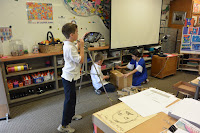 |
| The set designers measure the stage |
 |
| Costume and prop designers at work |
 |
| Actors audition for parts |
Here is how 5th grade teacher, David Ries, described the process in a letter to parents:
We are currently immersed in the production of our fifth grade environmental play. The process is our most ambitious application of the Design Thinking principles that we engage in here at Francis Parker.
The students started with a bit of research and discussion about what environmental issues were important to them. Students then decided how they wanted to contribute to the process, from writing to acting to set design and costumes. And once the script was finished, we broke up into our groups and began the arduous task of bringing our ideas to fruition. The Design Team are providing the structure and support for students to help us collaborate on a daily basis. It is wonderfully messy.
Sending a fifth grader to design a set or start rehearsing lines can be tricky. Sometimes even chaotic. Still, we map out our daily plans, we work our way through differences of ideas, and we reflect on how things are going well and how they are not. Then we adjust our course.
We have ten working days until rehearsals begin. I guarantee struggles and setbacks along the way, but we will get there. We will put on an environmental play that may or may not save the world. But students will walk away with valuable skills that will help them to be independent thinkers and workers. They will have produced a substantial piece of work as a member of a collaborative team.
That is significant.








